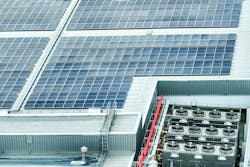IoT Architecture Enables Smarter, Greener Facility Management
As the world’s dual transition toward a digital and sustainable future is challenging how businesses leverage technology to achieve their sustainability goals, it has become evident that modern technology is providing answers to some of our society’s oldest challenges.
While technology may hold the key to maintaining the longevity of our planet, many organizations continue to struggle with finding the right ESG investments and solutions for their needs. The current state of sustainability and facility management is evolving rapidly, driven by increasing awareness of environmental impacts and the need for energy efficiency. At Capgemini, we have worked to combine digital engineering, hybrid intelligence, and IoT to optimize building assets consuming energy and help organizations accelerate their sustainability efforts. We call this effort the Energy Command Center (ECC).
Research shows that the operations of buildings account for 30% of global final energy consumption and 26% of global energy-related emissions. With capabilities such as real-time monitoring and predictive analytics enabled by platforms like the ECC, enterprises can easily monitor their energy consumption and ensure optimal efficiency.
To face the challenges associated with climate change, mounting energy prices, limited resources, and concerns about security of supply, innovative solutions are the key to optimizing energy resources and pushing a sustainable future.
Rethinking Consumption
This year, government policies, volatile market forces, and societal demands are reshaping the pace and direction of the energy transition agenda. With the widespread recognition of climate change as a leading cause of future operational disruptions, 57% of global business leaders believe their business’ investment in clean tech will rise over the next 2-3 years. This is only heightened by global economic incentives such as the Inflation Reduction Act (IRA) and the EU Green Deal Industrial Plan.
And while 52% of businesses are expected to increase their sustainability investments in the next year, there are several challenges across the building sector and facility management, such as slow adoption of new solutions, inefficient processes, outdated and siloed systems, and reactive rather than predictive solutions that result in waste, higher costs, and inadequate decision making. Retrofitting or upgrading existing infrastructure will have a direct impact on the cost and scale of implementation as businesses justify the return on investment (ROI) for a building that’s already been utilized for most of its life.
Today, almost 80% of CO2 emissions come from energy. It is crucial for leaders to understand the carbon footprint of their facilities, specifically with growing regulatory risks and increased gas and electricity prices. The adoption of new solutions like the ECC will not only help enterprises address customer challenges regarding measuring and reporting, but also directly improve their bottom line as operations become more efficient with data-driven decisions. The platform will also assist businesses in meeting ESG reporting compliance and achieving their overall sustainability goals for carbon emissions reduction and net zero targets.
Although we are seeing new buildings inherently designed to be greener and more energy efficient, leveraging emerging technologies to address waste for buildings that need to be retrofitted is the fastest and least capital-intensive solution to reduce energy use, costs, and emissions.
Mastering Enterprise-Wide Efficiency
By leveraging an IoT-based architecture, the ECC platform has extensive monitoring and management capabilities. For example, the ECC monitors and manages all of Capgemini’s energy usage across India.
There are several capabilities required for a dynamic and proactive solution like ECC to thrive. These include:
- Offline reporting: Provides reporting on basic KPIs related to energy usage and carbon footprint, alongside trend analysis that offers insights to enable the journey towards net zero energy.
- Dynamic real-time monitoring: Through alerts, events, and notifications, the ECC facilitates connected equipment visualization and real-time assessment of energy usage and carbon impact.
- Proactive control and optimization: Leverages artificial intelligence (AI) and machine learning (ML) based advanced controls to drive highly efficient energy management and decarbonization efforts with prescriptive equipment maintenance through real-time monitoring and energy optimization.
With this platform fully operational, enterprises can measure and predict various metrics such as indoor air quality, energy intensity, water usage, the health of critical assets and operations, renewable energy generation, and the overall performance.
The proactive approach and applied learnings of IoT, AI, and ML developed in-house is what makes a platform like the ECC unique. Paired with inherent knowledge and understanding of the facility ecosystem and an innovative partnership with Schneider Electric, the ECC has driven a delivered impact of 29% in energy reduction across Capgemini’s eight campuses in India.
Owning Your Strategy
The sustainability journey is unique to every organization. Whether it is to achieve net zero, mitigate climate change, decrease emissions, or all the above, the road to the green future starts with those willing to take the first step.
Enterprises can expect to feel the benefits of data-driven solutions that can quickly scale and control the success of energy decarbonization.
For instance, the ECC helped a leading global consumer-packaged goods company identify potential savings of up to 30% in waste, water, and energy efficiency. A separate life sciences manufacturer discovered a yearly net savings of €2M and 21% in energy consumption through a maturity assessment and energy efficiency transformation roadmap.
Technology has a substantial role in every organization’s sustainability strategy to mitigate the impacts of climate change and other environmental challenges. With efficient energy management at the top of sustainability agendas, it’s clear that accelerating the creation and implementation of innovative solutions hinges not just on the technology, but collective action and a shift in mindset.
Outside of relying on emerging technologies like the ECC, organizations can take up several alternative initiatives to meet their sustainability goals:
- Invest in sustainable supply chains: Implement sustainable practices in the supply chain such as sourcing materials responsibly to reduce waste in downstream processes and ensure fair labor processes.
- Waste reduction programs: Focus on programs like reducing single-use plastics, recycling, and composting are just a few ways in which an organization can encourage a circular economy.
- Optimization of fleets: Invest in fleet management by switching to sustainable fuels, promote fuel-efficient driving behaviors, or utilize battery-powered vehicles to reduce emission and fuel consumption; this can ultimately reduce an organization's carbon footprint.
- Employee engagement: Promote active participation through company-wide sustainability programs, committees, and training to empower employees to not only incorporate sustainable behaviors into their daily work routines but drive them to feel invested in their company’s overall sustainability goals.
While it’s proven that solutions such as the ECC can deliver incredible results, emerging technologies should not be viewed as a silver bullet or a quick fix. Addressing the climate and ecological crisis will require systematic change and commitment that goes beyond the use of technology. Although every organization’s sustainability journey is their own, the importance of leveraging existing ecosystems through co-innovation or partner expertise and exploring proven, scalable, and readily available solutions like the ECC, will be crucial as organizations must act decisively and at pace to realize their sustainability goals and ultimately bring corporate activity, and its outputs, back into balance.
About the Author
Ranjeet Vaishnav
Ranjeet Vaishnav is senior director of engineering and research and development services for energy transition & utilities, Capgemini.


